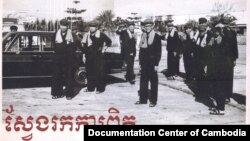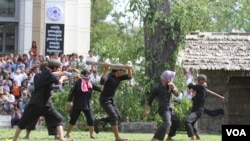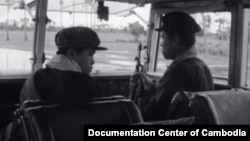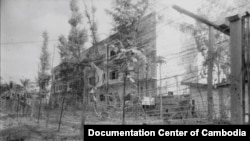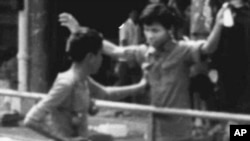On the morning of January 7, 1979, then Foreign Minister Ieng Sary was riding the train. As he rolled out of Phnom Penh, heading northwest, Vietnamese troops were entering the capital as Khmer Rouge forces were routed.
As depicted in Nayan Chanda’s bestselling 1986 book Brother Enemy: The War After the War, Ieng Sary was accompanied on the train by Khmer Rouge soldiers, many of them injured from the fighting and most in a state of panic. The three year, eight month and 20 day experiment in social engineering known as Democratic Kampuchea, the name the Communist Party of Kampuchea (CPK) gave to their state, had ended.
The choice of transport for Ieng Sary’s retreat toward the Thai-Cambodian border—where the Khmer Rouge would continue fighting for almost two decades—was apt. It serves as a reminder of the regime’s use of rail transport in its attempts to force Cambodians into the leadership’s vision of the country as an agrarian utopia.
Passenger train services restarted last month for the first time in years, renewing interest in the history of Cambodia’s small railway network. Tracks were first laid by the French colonial authorities that ruled Cambodia as a protectorate from the mid-19th century.
A 385-kilometer (240-mile) line connecting Phnom Penh to the Thai border was constructed between 1929 to 1942. The post-independence government of King Norodom Sihanouk in the 1960s connected the capital city with the ruler’s eponymous port town of Sihanoukville to the southwest, with work on the 266-kilometer (165-mile) line completed in 1969.
As Prime Minister Hun Sen reportedly noted while riding the first passenger service on April 30, the railways “were almost totally destroyed by war more than 40 years ago.” But trains ran on the two lines, off and on, until the early 2000s, when passenger services halted until last month’s reboot.
And after the Khmer Rouge took power in 1975 the railways were still in good enough shape to be of use to the party’s leadership. An undated photo shows the regime’s Brother Number One Pol Pot, his second, Nuon Chea, Defense Minister Vorn Vet and the infamous military commander Ta Mok riding the rails together while in power.
The photo, which shows the top cadres decked in the movement’s recognizable black pajamas and krama scarves, was used for propaganda purposes. But the regime also found a darker use for the rail network—as means to carry out the forced transportation of Cambodians on an industrial scale.
In the second wave of evacuations of Phnom Penh—the first came immediately after the Khmer Rouge took the city in April 1975—an estimated 500,000 people were taken out of the capital, said Sirik Savina, a researcher who is heading the Museum of Memory project at the Sleuk Rith Institute. Trains were an important way to transport people to the countryside, where they were put to work clearing forests for agriculture and other labor in the northwest, she said.
“People were evacuated with their whole families,” Savina said, “but only one or two of them managed to survive and return [to Phnom Penh] in the end.”
Almost exactly 41 years on, Ly Chhorvy, 60, can still remember vividly the shock of being forced away from her life in the city so suddenly. She would end up losing most of her family, including both parents, during the Khmer Rouge’s reign, in which time an estimated 1.7 million people were killed or died from starvation and overwork.
Khmer Rouge soldiers forcibly corralled Ly Chhorvy, 10 of her family members, and other villagers, into trucks and transported them from Kompong Chhnang province’s Sala Lek Pram town—where they had been staying since being evacuated from the capital only weeks earlier—back to Phnom Penh.
People were given no choice about where they went next, Ly Chhorvy told VOA Khmer by phone from her home in Banteay Meanchey province. “They had to leave when ordered,” Ly Chhorvy said. “We had no idea where we were being taken. We only realized [we were going on a train] when we arrived at the main train station [in Phnom Penh].”
“People were arriving at the station empty handed. They distributed some pieces of bread and palm sugar cookies,” she said. “But we got no water, so parents were rushing to get some water for their children, who screamed in all of the train’s cars. The Khmer Rouge soldiers were rushing to get the train started.”
Once the train departed, soldiers were posted in each wagon to try to keep order among what Ly Chhorvy described as a “countless number” of unwilling passengers. “The guard shouted at the weeping passengers: ‘Don’t scream and cry, because we’re almost there. Or I will throw you off the train,’” she recalled.
“I saw many people who fell sick. Some of the women were pregnant and delivered babies without a midwife. Some were injured and were bleeding all over the train floor.”
The journey ended at a remote area in Pursat province, where she and her family were put to work.
Transport Ministry spokesman Chan Samleng, who heads the Railways Department, said his colleagues who have worked on Cambodia’s railways in the years since the Khmer Rouge were often reminded of the troubling history, which also saw many railway workers become victims of the brutal regime.
“In fact, we cannot forget that memory. It isn’t easily deleted, given their mistreatment of the [railway] workers,” Chan Samleng said. “I can feel their pain at that mistreatment.”
The 1975 forced transfers of the population were a key subject of the first portion of Case 002 at the Khmer Rouge Tribunal, which concluded with the guilty verdict against Nuon Chea and the regime’s head of state, Khieu Sampan, in 2014. Ieng Sary died while standing trial, aged 87.
“The second evacuation was ordered by and was the responsibility of the CPK’s permanent committee,” said Sirik Savina. “They moved people to the northwest to make them do hard labor and provided them with little food, and they were hit by illnesses—most of them were killed by illness.”
“I think people should know this,” she added. “They should not forget that the evacuation marked the start of massacre, starvation, and hard labor of their older generation during the Khmer Rouge.”




